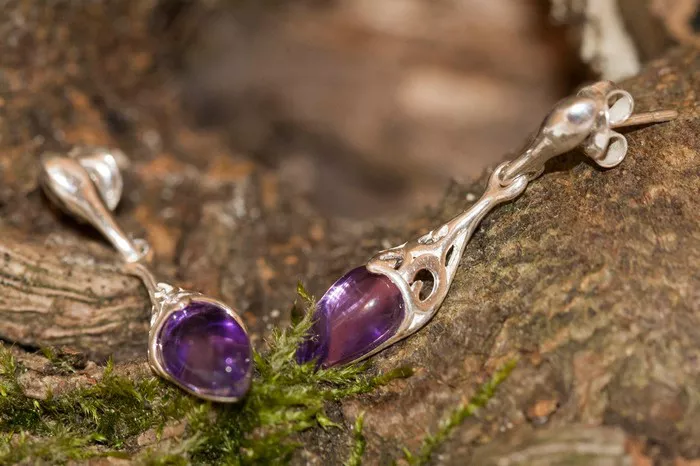Amethyst, a member of the quartz family, has been revered for its unique purple hue and mystical properties for centuries. Its name, derived from the Greek word “amethystos,” meaning “not drunk,” reflects its ancient association with sobriety and the prevention of intoxication. But beyond its historical significance and beautiful appearance, what are the true qualities of amethyst? Is it a positive or negative gemstone? This article aims to provide a comprehensive understanding of amethyst from a professional jewelry appraiser’s perspective, exploring its characteristics, symbolism, benefits, and potential drawbacks.
Characteristics of Amethyst
Amethyst is a variety of quartz that exhibits a rich purple color due to trace amounts of iron and manganese within its crystalline structure. This stunning gemstone can range in color from pale lavender to deep violet, with some pieces displaying a striking red-violet hue known as “Siamese amethyst.” Its hardness of 7 on the Mohs scale makes it suitable for everyday wear, while its vitreous to waxy luster adds to its appeal.
Amethyst is commonly found in geological formations known as pegmatites, which are large, coarse-grained igneous rocks. Brazil is the world’s largest producer of amethyst, but significant deposits are also found in countries like Uruguay, Zambia, and Madagascar. The gemstone’s popularity has led to a variety of cutting styles, including cabochons, beads, and faceted gems, allowing it to be incorporated into a wide range of jewelry pieces.
Symbolism and Historical Significance
Throughout history, amethyst has been associated with a myriad of symbolic meanings and beliefs. In ancient Greece and Rome, it was believed to prevent drunkenness and was often worn by soldiers and politicians to maintain clarity and sobriety during banquets. The bishops of the Catholic Church were once granted amethyst rings as a symbol of their office, and the gemstone was also used in medieval lapidary texts to symbolize piety, humility, and spiritual wisdom.
In addition to its sobriety associations, amethyst has been linked to royalty and power. Many ancient civilizations, including the Egyptians and Persians, valued amethyst for its protective and healing properties. It was believed to guard against evil spirits, protect against poisoning, and enhance meditation and spiritual growth. These beliefs have persisted throughout the ages, contributing to amethyst’s enduring popularity as a gemstone of mystical and spiritual significance.
Benefits of Amethyst
From a jewelry appraiser’s perspective, amethyst offers numerous benefits that make it a highly sought-after gemstone. Here are some of the primary advantages:
Emotional and Spiritual Healing
Amethyst is often recommended for emotional healing and stress relief. Its calming purple hue is believed to promote inner peace, reduce anxiety, and enhance spiritual growth. Many people find that wearing amethyst jewelry can help them maintain a positive mindset and cope with life’s challenges.
Physical Healing Properties
In addition to its emotional benefits, amethyst has been associated with various physical healing properties. Some believe that it can help alleviate headaches, improve sleep quality, and enhance the immune system. While these claims have not been scientifically proven, many people find that wearing amethyst jewelry provides a sense of well-being and comfort.
Enhancement of Personal Energy
Amethyst is also known for its ability to enhance personal energy and balance the chakras. The gemstone’s vibrations are believed to resonate with the crown chakra, the energy center located at the top of the head, promoting spiritual awareness and connection with the divine. By wearing amethyst jewelry, individuals can potentially tap into their inner wisdom and higher consciousness.
Versatility in Jewelry Design
Amethyst’s versatility makes it an excellent choice for a wide range of jewelry designs. Its rich purple color complements both casual and formal attire, making it a popular choice for engagement rings, pendant necklaces, earrings, and bracelets. With its hardness and durability, amethyst can be shaped and polished into various styles, catering to diverse tastes and preferences.
Potential Drawbacks of Amethyst
While amethyst offers numerous benefits, there are also some potential drawbacks to consider when evaluating this gemstone.
Heat Sensitivity
Amethyst is known to be sensitive to heat. Exposure to high temperatures can cause the gemstone to fade or change color, reducing its value and appeal. Therefore, it is essential to avoid exposing amethyst jewelry to direct sunlight, hot water, or steam.
Price Fluctuations
The price of amethyst can vary significantly depending on factors such as color saturation, clarity, and cut. While high-quality amethyst pieces can fetch high prices, lower-quality stones are relatively affordable. This variability can make it challenging for consumers to assess the true value of a particular amethyst gemstone.
Treatments and Enhancements
Some amethyst gemstones have undergone treatments or enhancements to improve their appearance. These treatments can include heating, irradiation, or dyeing, which can alter the gemstone’s natural properties. While treated amethyst may still be beautiful, it is important for consumers to be aware of any treatments when purchasing jewelry.
Conclusion
Ultimately, whether amethyst is considered a positive or negative gemstone depends on individual beliefs and experiences. For those who believe in its healing properties and mystical significance, amethyst can be a powerful and positive force in their lives. For others, it may simply be a beautiful and elegant gemstone that adds a touch of elegance to their wardrobe. Regardless of one’s perspective, amethyst remains a cherished and revered gemstone in the world of jewelry.
Related topic:
- Can You Layer Amethyst and Alexandrite Necklaces Together?
- How to Test if Your Amethyst Is Real
- How Hard Wearing Is Amethyst


